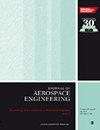基于遗传算法的跨声速低雷诺数翼型优化
IF 1.1
4区 工程技术
Q3 ENGINEERING, AEROSPACE
Proceedings of the Institution of Mechanical Engineers Part G-Journal of Aerospace Engineering
Pub Date : 2023-11-14
DOI:10.1177/09544100231207558
引用次数: 0
摘要
对跨声速低雷诺数条件下的二维翼型进行了优化设计。采用过渡模型(k-ω SST γ-Re θ)的Navier-Stokes流动求解器对适应度函数进行求解。比较了单点和多点优化方案的优化结果。此外,在低雷诺数(Re = 17000)和高亚音速流(公式:见文)条件下,研究了马赫数和攻角对优化后翼型气动特性的影响。结果表明,在整个马赫数范围内,常规翼型相应的阻力散度马赫数曲线几乎呈平行位移。相比之下,当马赫数大于0.75时,非常规翼型开始显示显着的阻力减少。此外,由于激波的形成、运动、类型和强度等因素,最大升阻比受马赫数的影响较大。此外,两种翼型结论的显著区别在于,传统翼型的升力波动随马赫数的增加而增大。然而,非传统的翼型显示出相反的趋势。本文章由计算机程序翻译,如有差异,请以英文原文为准。
Optimization of transonic low-Reynolds number airfoil based on genetic algorithm
A 2-D airfoil shape optimization in transonic low-Reynolds number regime is conducted. A Navier–Stokes flow solver with a transition model (k-ω SST γ-Re θ ) is used to evaluate the fitness function. Single-point and multi-point formulations of the optimization results are compared. In addition, the effects of Mach number and angles of attack on aerodynamic characteristics of the optimized airfoils are investigated under low Reynolds number (Re = 17,000) and high-subsonic-flow ([Formula: see text]) conditions. The results show that the corresponding drag divergence Mach number curves of the conventional airfoil present almost a parallel shifting at the entire Mach number range. By contrast, the unconventional airfoil starts showing a significant drag reduction when Mach number is greater than 0.75. Besides, the maximum lift-to-drag ratio is highly influenced by the Mach number because of the formation, movement, type, and strength of a shock wave. In addition, the distinguishing difference in the conclusion between two airfoils is that the lift fluctuation of the conventional airfoil amplifies with the increase of the Mach number. However, the unconventional airfoil shows an opposite trend.
求助全文
通过发布文献求助,成功后即可免费获取论文全文。
去求助
来源期刊

CiteScore
2.40
自引率
18.20%
发文量
212
审稿时长
5.7 months
期刊介绍:
The Journal of Aerospace Engineering is dedicated to the publication of high quality research in all branches of applied sciences and technology dealing with aircraft and spacecraft, and their support systems. "Our authorship is truly international and all efforts are made to ensure that each paper is presented in the best possible way and reaches a wide audience.
"The Editorial Board is composed of recognized experts representing the technical communities of fifteen countries. The Board Members work in close cooperation with the editors, reviewers, and authors to achieve a consistent standard of well written and presented papers."Professor Rodrigo Martinez-Val, Universidad Politécnica de Madrid, Spain
This journal is a member of the Committee on Publication Ethics (COPE).
 求助内容:
求助内容: 应助结果提醒方式:
应助结果提醒方式:


